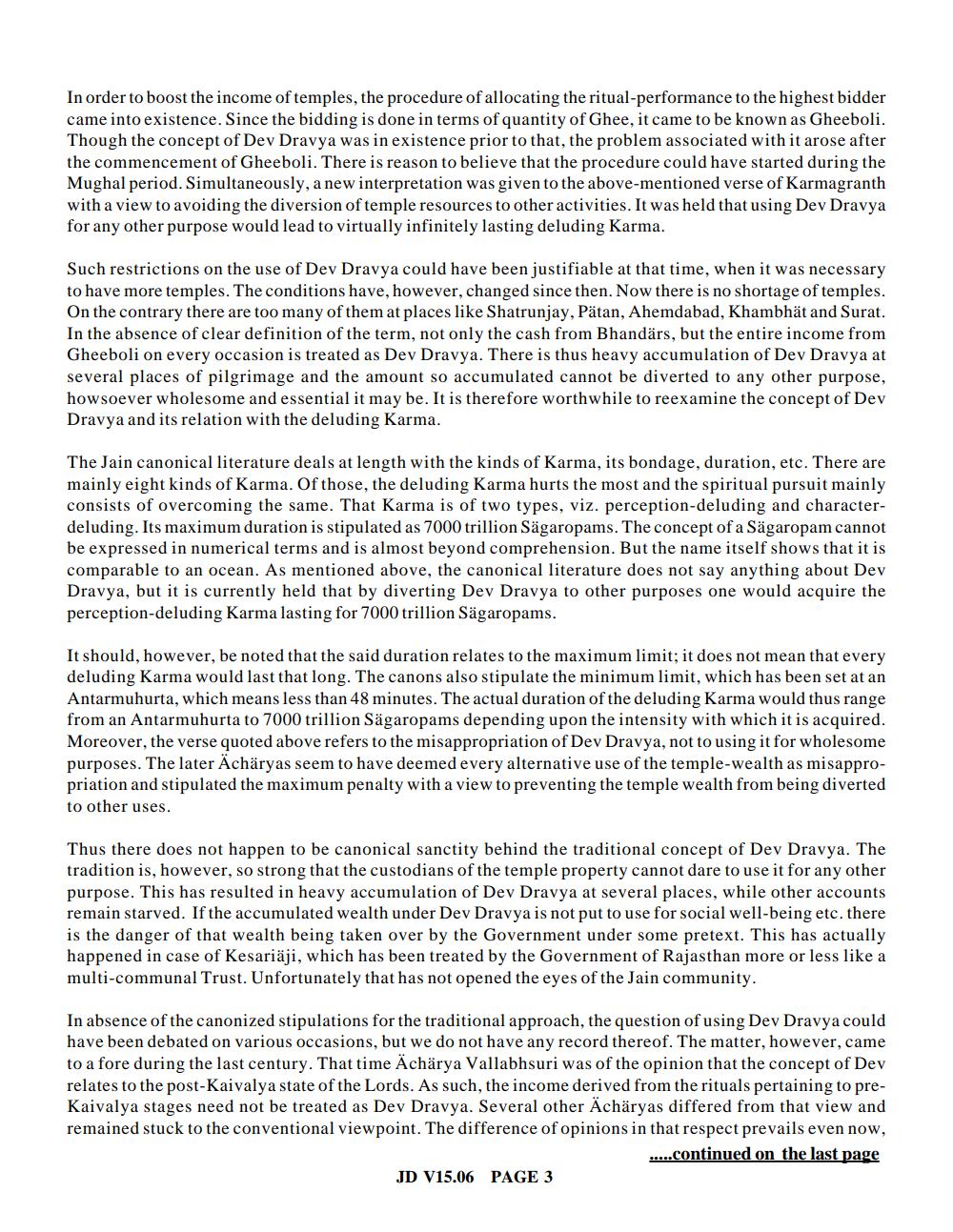Book Title: Dev Dravya Author(s): Manu Doshi Publisher: Manu Doshi View full book textPage 3
________________ In order to boost the income of temples, the procedure of allocating the ritual-performance to the highest bidder came into existence. Since the bidding is done in terms of quantity of Ghee, it came to be known as Gheeboli. Though the concept of Dev Dravya was in existence prior to that, the problem associated with it arose after the commencement of Gheeboli. There is reason to believe that the procedure could have started during the Mughal period. Simultaneously, a new interpretation was given to the above-mentioned verse of Karmagranth with a view to avoiding the diversion of temple resources to other activities. It was held that using Dev Dravya for any other purpose would lead to virtually infinitely lasting deluding Karma. Such restrictions on the use of Dev Dravya could have been justifiable at that time, when it was necessary to have more temples. The conditions have, however, changed since then. Now there is no shortage of temples. On the contrary there are too many of them at places like Shatrunjay, Pätan, Ahemdabad, Khambhät and Surat. In the absence of clear definition of the term, not only the cash from Bhandars, but the entire income from Gheeboli on every occasion is treated as Dev Dravya. There is thus heavy accumulation of Dev Dravya at several places of pilgrimage and the amount so accumulated cannot be diverted to any other purpose, howsoever wholesome and essential it may be. It is therefore worthwhile to reexamine the concept of Dev Dravya and its relation with the deluding Karma. The Jain canonical literature deals at length with the kinds of Karma, its bondage, duration, etc. There are mainly eight kinds of Karma. Of those, the deluding Karma hurts the most and the spiritual pursuit mainly consists of overcoming the same. That Karma is of two types, viz. perception-deluding and characterdeluding. Its maximum duration is stipulated as 7000 trillion Sägaropams. The concept of a Sägaropam cannot be expressed in numerical terms and is almost beyond comprehension. But the name itself shows that it is comparable to an ocean. As mentioned above, the canonical literature does not say anything about Dev Dravya, but it is currently held that by diverting Dev Dravya to other purposes one would acquire the perception-deluding Karma lasting for 7000 trillion Sägaropams. It should, however, be noted that the said duration relates to the maximum limit; it does not mean that every deluding Karma would last that long. The canons also stipulate the minimum limit, which has been set at an Antarmuhurta, which means less than 48 minutes. The actual duration of the deluding Karma would thus range from an Antarmuhurta to 7000 trillion Sägaropams depending upon the intensity with which it is acquired. Moreover, the verse quoted above refers to the misappropriation of Dev Dravya, not to using it for wholesome purposes. The later Achäryas seem to have deemed every alternative use of the temple-wealth as misappropriation and stipulated the maximum penalty with a view to preventing the temple wealth from being diverted to other uses. Thus there does not happen to be canonical sanctity behind the traditional concept of Dev Dravya. The tradition is, however, so strong that the custodians of the temple property cannot dare to use it for any other purpose. This has resulted in heavy accumulation of Dev Dravya at several places, while other accounts remain starved. If the accumulated wealth under Dev Dravya is not put to use for social well-being etc. there is the danger of that wealth being taken over by the Government under some pretext. This has actually happened in case of Kesariäji, which has been treated by the Government of Rajasthan more or less like a multi-communal Trust. Unfortunately that has not opened the eyes of the Jain community. In absence of the canonized stipulations for the traditional approach, the question of using Dev Dravya could have been debated on various occasions, but we do not have any record thereof. The matter, however, came to a fore during the last century. That time Acharya Vallabhsuri was of the opinion that the concept of Dev relates to the post-Kaivalya state of the Lords. As such, the income derived from the rituals pertaining to preKaivalya stages need not be treated as Dev Dravya. Several other Acharyas differed from that view and remained stuck to the conventional viewpoint. The difference of opinions in that respect prevails even now, .....continued on the last page JD V15.06 PAGE 3Page Navigation
1 2 3 4 5 6 7 8
